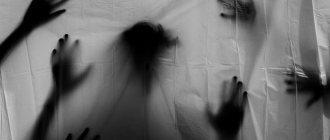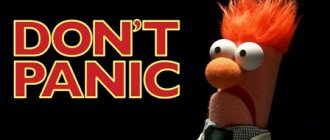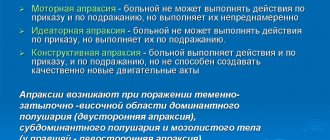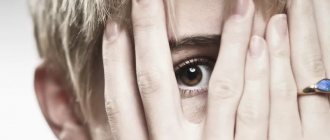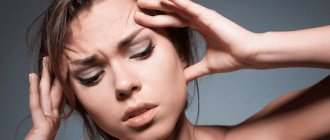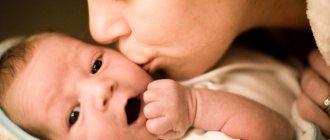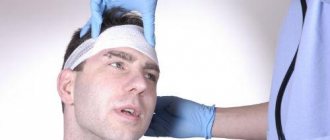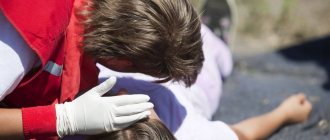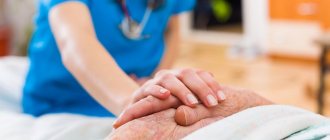Panic attacks in children are sudden, provoked or causeless attacks of fear, accompanied by autonomic disorders. The attack lasts up to minutes, anxiety turns into panic, blood pressure rises, breathing and heartbeat quicken, and tremors of the limbs occur. Disorders of the digestive tract and urinary system are often observed. The main diagnosis is carried out by a psychiatrist and, if necessary, supplemented by an examination by a clinical psychologist or neurologist. Treatment includes the use of medications to stop attacks and psychotherapy to prevent their subsequent development.
Children are usually much more sensitive physically and psychologically than adults. Every person faces certain fears in their life, but children are more defenseless due to their age and lack of experience. Panic attacks in children require treatment to avoid serious consequences.
Classification of panic attacks in childhood
Depending on the number of manifestations:
- Large (full-scale) attack - four or more symptoms.
- Minor attack – less than four symptoms.
Depending on the prevailing manifestations:
- Typical (vegetative). Symptoms such as increased pulse and heart contractions, spasms, nausea, and fainting prevail.
- Hyperventilation. Main manifestations: increased breathing, reflex cessation of breathing.
- Phobic. phobias predominate . Fear arises in situations that, according to the patient, are dangerous and can provoke a panic attack.
- Affective. They manifest themselves in the form of depression, obsessive thoughts, constant internal tension, melancholy and angry states, and aggressiveness.
- Depersonalization-derealization. The main symptom is detachment, a feeling of unreality of what is happening.
Causes of childhood panic attacks
Fear is a natural human reaction to danger, so fear is the fundamental cause of panic attacks.
Fear mobilizes the body to avoid something or run away. In childhood, this may be fear of parents, fear of being “bad,” fear of the dark or shadow. For teenagers, fear can manifest itself in the form of fear of self-expression, fear of not being liked or making the wrong choice. A more detailed reason that is more likely to cause this psychological disorder to appear in a child is anxiety. In this case, children suffer because it is very easy to inspire something. In addition, children with painful nervousness, children and adolescents with a lack of attention, both from parents and from peers, also fall into the risk zone. In addition to psychological characteristics, there are also biological and social factors.
Biological reasons include:
- hormonal surges (for example, during puberty),
- neurological injuries or diseases,
- alcohol or drug poisoning,
- In some cases, heredity may have an effect.
Social factors:
manifest themselves in family dysfunction, the complexity of interaction between the child and society.
It is important to understand that panic attacks are an interaction of at least two of the three factors, in other cases it will already be associated with general organ diseases.
Is it possible to outgrow PA?
Some dads and moms hope that a panic attack, like a hysteria, will simply go away on its own with age. But doctors warn: if PA is not treated, it will develop into panic disorder, mental illness, and will interfere with the teenager’s ability to socialize, build relationships or a career.
That is why parents need to know the symptoms of PA in their child:
- rapid heartbeat and frequent shallow breathing;
- pale skin;
- perspiration on the palms, back;
- complaints of nausea, stomach cramps;
- tremor of the limbs;
- headache or dizziness.
These symptoms indicate problems with the autonomic part of the nervous system and require qualified therapy.
Reasons for appearance
It is mistakenly believed that panic attacks most often occur in women under the age of 30 and are caused only by stress or pregnancy. The disease can also occur in men, and quite often. Experience shows that men are less likely to see a doctor with such symptoms. The causes of panic attacks are not fully understood; this problem has not yet been solved by specialists.
To one degree or another, the disease manifests itself in 5% of the world's population, but not everyone develops it and becomes pathological. The greatest number of complaints about panic attacks was observed among residents of large cities. Residents of megacities are at risk. The age of the main group of patients is 25-45 years. Elderly people also have such disorders, but they occur more easily.
There are several reasons for panic attacks:
- physiogenic;
- psychogenic;
- biological
Physiogenic factors include stress, physical overload, taking various drugs, stimulants, steroids, and acclimatization. A panic attack can be triggered by alcohol. Psychogenic and biological factors are more complex. The disorder manifests itself against the background of a reverent attitude towards one’s health, fear of death, fear of going crazy, or losing attractiveness. This is true of men and women equally.
What happens to the child?
During a panic attack, something like this happens in the human body:
- A sharp surge of adrenaline.
- The consequence is vasoconstriction, increased breathing and heart rate.
- Increased blood pressure.
- Rapid breathing increases the release of carbon dioxide, which further increases anxiety.
- Carbon dioxide changes the pH of the blood. This leads to dizziness and numbness of the limbs.
- Vasospasm slows down the delivery of oxygen to the tissues: lactic acid accumulates, increasing the manifestation of the attack.
Causes
Panic attacks in children, causes
- Parental overprotection, instilling increased anxiety when raising a child, constant control over personal time, studies, and the child’s health.
- A family where the parents have some form of chemical dependence (alcoholism, drug addiction), which often leads to conflicts.
- Emotional isolation of a child in the family occurs when parents do not pay enough attention to their children, and the child lacks emotional contact with one or both parents.
- Constant conflicts in the family between relatives for various reasons: psychological incompatibility, everyday problems, betrayal, etc.
- External factors: high competition at school, fear of ridicule, misunderstanding, fear of mistakes, etc.
- Children's fears: fear of the dark, fear of abandonment, etc.
- Physiological reasons: overwork, somatic diseases, etc.
For a child, his family is the whole world, and the climate in the family, how emotionally connected the parents are with the child, whether the child feels their love, largely depends on his emotional and mental state.
Cost of services
| TREATMENT OF DEPRESSION, NEUROSIS | |
| NAME OF SERVICE | price, rub. |
| Consultation with a therapist (observation) | 3,000 rubles |
| Consultation with a neurologist (observation) | 3,000 rubles |
| Consultation with a psychologist | 2,000 rubles |
| Psychiatrist consultation | 5,000 rubles |
| Consultation with the head of the department | 4,500 rubles |
| CONSULTATIONS, INITIAL INSPECTION | |
| NAME OF SERVICE | price, rub. |
| Telephone consultation | For free! |
| Telephone consultation for relatives | For free! |
| Initial consultation with a psychiatrist-narcologist in a hospital | For free! |
| Initial consultation with a psychologist by phone | For free! |
| Visit of a narcologist and consultation at home | 2,000 rubles |
| Consultation with a psychotherapist, psychologist in the clinic | 2,000 rubles |
| Initial appointment, examination by a doctor, cubital catheter, ECG | 2,500 rubles |
| Consultation with a therapist, neurologist, surgeon | 3,000 rubles |
| Family consultation with a psychologist | 3,000 rubles |
| Psychiatrist consultation | 4,000 rubles |
| Consultation with the head of the department | 4,500 rubles |
| PROMOTIONS AND DISCOUNTS | |
| When applying again | 5% discount on treatment |
| Disabled people and war veterans | 5% discount on treatment |
| Large families | 10% discount on treatment |
* Dear patients! The administration tries to promptly update the price list posted on the website, but in order to avoid possible misunderstandings, we ask you to clarify the cost of services on the day of your call by calling 24/7.
The posted price list is not an offer.
Get a free consultation
+7(495) 798-30-80
Symptoms of panic attacks
Moments of panic attacks in children occur spontaneously, without any apparent reason. They do not pose a threat to the children’s lives; they are characterized by vegetative disorders, including:
- feeling of dry mouth;
- pallor of the epithelium;
- increased anxiety;
- hypertension;
- increased sweating;
- ringing in the ears and fog before the eyes;
- trembling, numbness of limbs.
During an attack, children often experience tremor of the eyelids and lips, pain in the chest area, and dizziness. Also, with PA, they may experience nausea that is not related to nutrition. Often the attack ends suddenly, accompanied by significant urination (light urine with low relative density). Since children cannot always explain their condition, point out painful areas, as well as a variety of symptoms, the anomaly is not always diagnosed on time.
If a panic attack does happen
It should be remembered that it can arise completely suddenly, so you need to be prepared to meet it. Here are some ways to deal with a panic attack:
Breath control
Try to slow down your breathing so that its frequency does not exceed 4-5 breaths per minute. Place your hands on your upper abdomen. It is better to close your eyes. You can practice this exercise at home in a calm environment.
Red Herring
You may remember something pleasant or even funny. Of course, it is very difficult to switch from a negative state, but it’s worth turning your thoughts in a different direction, stopping thinking about what actually caused the attack. It is advisable to offer to eat something or drink water or juice. It is necessary to break the vicious circle of panic by transferring the body’s attention to other actions.
The periods between panic attacks can be characterized by either a complete absence of negative signs or chronic anxiety and tension. Blocking panic symptoms with sedatives only makes the problem worse.
Prognosis and prevention
The prognosis for panic attacks in children is favorable in the absence of comorbid conditions - anxiety, depression, hypochondria. The more tragic the child perceives the attacks, the more often they are reinforced by the anxious attention of parents and medical workers, the greater the likelihood of complications - agoraphobia, maladjustment in society. Prevention of panic disorder - creating home comfort, maintaining close family relationships. Emotional interest in the child’s life, moral support, and unconditional acceptance are important. Relapse prevention is based on periodic visits to a psychotherapist and taking medications without focusing on the disease. Statements like: “if you don’t take the pills, the attacks will start again” are unacceptable. In a tense school environment, it is worth discussing the presence of the disease with the school psychologist or class teacher.
What to do in childhood
Psychologists consider creativity to be a good way to transform emotions. It allows you to free yourself from experiences, giving them a different form (music, poetry, prose, paintings). If a teenager does not find ways to release his emotions, they destroy him from exhaustion. Against this background, conflicts arise with parents, teachers, friends and loved ones. It is difficult for a teenager to figure out who supports him and who is trying to harm him. Often he compensates for disharmony with alcohol and drugs.
Girls have panic attacks much more often than boys. This is explained by the fact that the female sex is naturally more sensitive and emotional. You shouldn’t take this as a lady’s whims. If a girl has become nervous, whiny, her mood and desires often change - this is an alarming signal for both the parents and the teenager himself.
The prognosis for treatment of such conditions is good. It is possible to get rid of them without resorting to medications. Sometimes a few conversations with a psychologist or psychotherapist are enough.
However, a favorable outcome is possible only if there is a trusting relationship between parents and child. After all, an unhealthy family environment is the first factor in the development of neuroses and other mental disorders in adolescents. If parents do not pay due attention to the child, do not strive to understand and hear him, he finds solace in dubious companies and subcultures.
Psychotherapist of the highest category, Candidate of Medical Sciences: Galushchak Alexander Vasilievich on the causes of panic attacks in children and adolescents and methods of treatment in the video:
First aid
First of all, during an attack, you need to calm down and begin to think that a panic attack does not pose a health hazard. No one has ever died from this.
You need to learn to control your breathing while breathing evenly and elongated. It helps to start counting or considering what is around.
If a loved one is nearby during an attack, then you need to take him by the hand and talk.
You must try to completely relax and think about good things. If you feel hot, you need to wash with cold water. If it’s cold, you can drink tea or take a warm shower.
What to do during an attack?
Symptoms most often appear spontaneously, regardless of time and place. The child’s behavior changes dramatically, some vegetative signs of the attack are visible from the outside (severe pallor of the face, sweating, trembling). Children tend to seek help from others, albeit wordlessly.
A teenager can be taught the following self-help methods:
- move the object of attention - reading signs or advertisements, studying patterns on the asphalt, looking at passers-by;
- various grounding techniques (“grounding”), which the doctor will select together with the patient;
- maximum relaxation - you can sit or lie down in any safe place, regardless of others;
- start reading your favorite poem out loud or sing an excerpt from a song, try to remember the phone numbers of your loved ones;
- slow diaphragmatic breathing - the psychiatrist will clearly demonstrate the techniques and teach the patient;
- After an attack, seek help from adults, not necessarily parents.
The same recommendations apply if the attack occurs in another person. The main thing is to provide maximum comfort and reassure the victim. A panic attack is not fatal, the symptoms are temporary!
Panic attacks in children: treatment
Since panic attacks in children can have both vegetative and psychological abnormalities, treatment of the disease involves alleviating both types of disorders. But parents should not expect quick results in this matter. The effectiveness of therapy can be achieved only after the factor provoking panic is discovered. As a rule, treatment is based on an explanation by a psychologist of how to behave during panic attacks and how they can be suppressed. If necessary, the child is assigned special sessions, during which the child develops a calm perception of the problems that arise in life, and changes his attitude towards himself and the world around him. As an addition to treatment, it is also common to use medications that help stop a panic attack.
Panic attacks in teenagers
Panic attacks in adolescents have a more pathological meaning and also often manifest themselves. We can say that teenagers are children at their core who are already participating in adult life. Therefore, while retaining childhood mental characteristics, they are already exposed to adult stress.
The etiology of teenage panic attacks is a combination of purely childhood causes of their occurrence and adults: stress, overexertion, psychological problems acquired by this time, and there are especially many unresolved interpersonal conflicts at this age.
Plus, there are certain teenage causes of panic attacks:
- Hormonal changes
- Periods of rapid growth, when the brain may perceive too sudden changes as a threat to life and health.
- Problems of establishing one's social status.
- A large number of certain physiological states: first menstruation, first sexual intercourse, first love, etc.
- Chronic and psychological disorders acquired by this time.
- Mental instability.
Main signs in children
A panic attack has the following symptoms:
- confusion of thoughts, loss of control over speech and emotions;
- heavy breathing, shortness of breath;
- rapid pulse, pressure surges;
- tremor, trembling, chills;
- sweating;
- nausea and dizziness;
- numbness of the limbs;
- dry mouth, pale skin;
- fear of going crazy or dying.
Children may exhibit several signs at once, as well as insomnia, depression, and depression. In this case, internal tension can persist for quite a long time. This phenomenon cannot be ignored, as it can result in a nervous breakdown or even suicide. During adolescence, a person begins to perceive the world as hostile, feeling lonely and abandoned.
Against the background of panic, unreasonable fears arise, which often develop into serious phobias. Panic attacks in adolescents are facilitated by behavioral stereotypes imposed from childhood. When a child tries to express emotions, parents scold him, saying “shut your mouth!” or “stop crying!”
At an older age, they teach him that in any situation one must behave with restraint and decentness. Most parents conduct such education in a raised voice, in a rude, frightening form. As a result, the child’s self-esteem falls; he is afraid to express his opinion and express himself in society. He suppresses feelings and emotions, which in the future results in panic attacks.
Often seemingly quiet and calm teenagers commit stupid spontaneous acts, show aggression and cruelty.
Adults believe that such behavior is not typical for them, however, such manifestations most often occur in notorious teenagers, such “gray mice”. The volcano of constantly suppressed emotions must find a way out somewhere. A good option might be sports clubs, dancing or other activities that require physical activity. In this way, the teenager releases mental negativity and tension through the body.
Diagnosis of panic attacks in children
Psychologists and psychotherapists are involved in identifying such problems. To make a correct diagnosis, the specialist will have to conduct a preliminary analysis of the symptoms indicated by the patient. In this case, the following information will be needed:
- when did such attacks first appear;
- frequency of seizure recurrences;
- factors provoking deterioration of the condition;
- the presence of similar problems in one of the family members;
- the existence of conflict situations related to work or family members;
- whether the patient experiences fainting.
For diagnosis, a specialist may also need additional information, which he can obtain through a neurological examination. But in the period between attacks it is quite difficult to detect neurological abnormalities. The attacks are accompanied by dilation of the pupils, changes in heart rate and breathing.
Nocturnal panic attacks
The occurrence of vegetative symptoms can be observed in patients at night. Such an attack lasts from several minutes to several hours and is characterized by increased intensity. There are two possible forms of manifestations of the disease at night:
- The patient cannot fall asleep for a long time, increasing fear and characteristic somatic symptoms appear that do not allow rest.
- A person wakes up from a feeling of terrible fear, panic and the thought that he needs to be saved. Some may calm down with the onset of dawn, while others may calm down with the awakening of relatives or if the light is turned on.
Medication and psychological assistance
The psychologist explains how to behave during attacks, how to prevent them, and teaches relaxation skills. Sessions are scheduled if necessary. During the sessions, a calm perception of emerging life problems is formed, a change in attitude towards oneself and people.
The optimal way to treat PA is considered to be a combination of work with a specialist and medications. The drugs should help stop PA. These include, for example, benzodiazepines. However, with constant use of these drugs, drowsiness and fatigue occur, which adversely affects the learning process.
There are contraindications, you need to consult a specialist!
Treatment
Treatment of panic attacks can give positive results in a short period of time if you consult a doctor in a timely manner, after the first incident. That is why it is necessary to monitor the teenager, monitor changes in his usual behavior and promptly fight to preserve the child’s mental health.
This problem can be successfully treated, but you need to achieve this not on your own, but strictly in tandem with a specialist who will study the problem of panic, the prerequisites for its occurrence, and prescribe appropriate therapy.
Most often, specialists prescribe the following groups of drugs:
- anticholinergics;
- neuroleptics;
- tranquilizers;
- ganglion blockers;
- nootropics;
- vascular agents;
- desensitizing drugs.
There are contraindications, you need to consult a specialist!
Related posts:
- Anonymity in psychiatry Psychiatry is a branch of medicine whose activities are aimed at studying the causes...
- Features of the course of schizophrenia in older people Schizophrenia is a mysterious, terrible disease. In the minds of the general public...
- The body's response to the cause of acute stress Acute stress reaction is a transient disorder of significant severity that...
- Obsessive-compulsive disorder (OCD): symptoms and treatment A mental illness manifested in the presence of obsessive ideas, thoughts, actions,…
